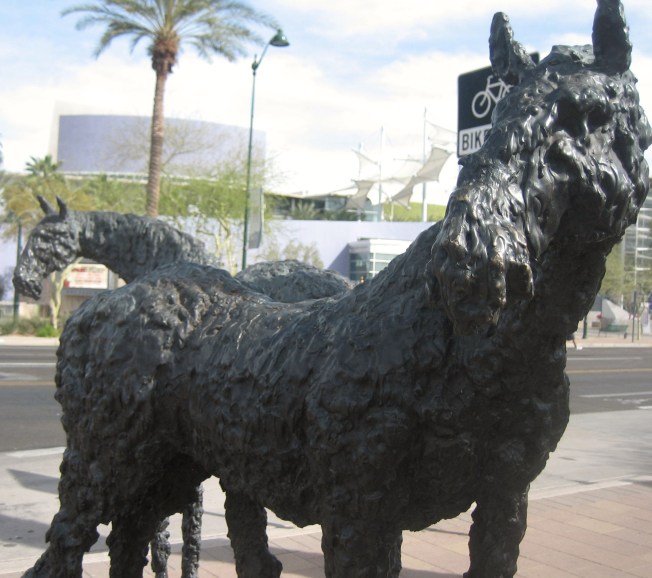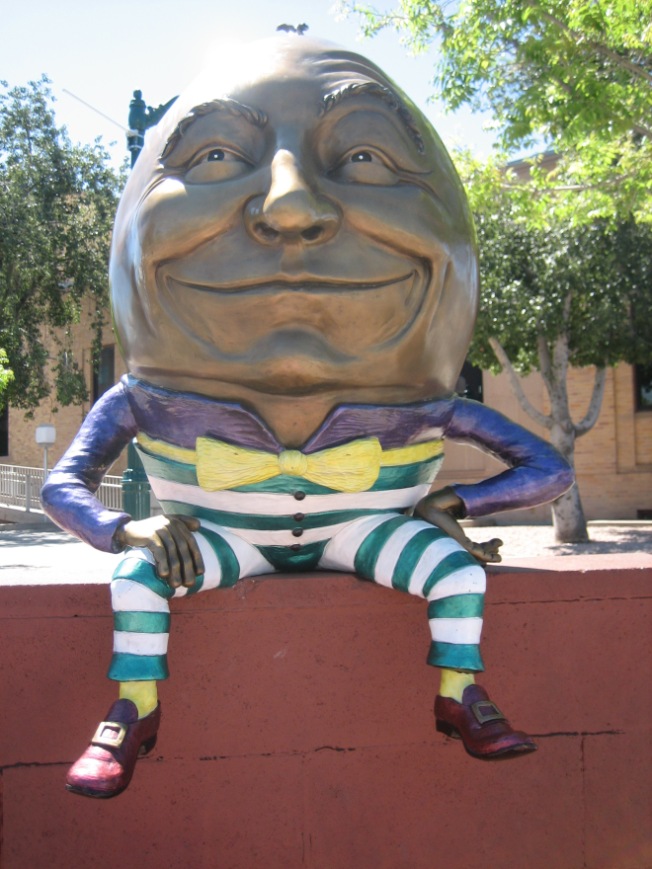
Nolagirl and I were walking towards the Mesa Arts Center on Main Street in Mesa, AZ.
I want to go look at that rocketship thing, I told her.
Right there by the lightrail stop? she confirmed.
I explained I’d taken phots of it in 2016. but I didn’t have any information about the artist. I wanted to find the name of the piece or the name of the artist or something.
We walked across the street, and Nolagirl gazed at the art. I wouldn’t have called it a rocketship, she said, but I get it.
I suspected it wasn’t supposed to represent a rocketship, but that was the closest comparision I could come up with. The round, tapering shape suggested a 1950s concept of space travel to me.
 I couldn’t find any permanent information about the art, but Mesa was having a silly event where folks could interact via text with inanimate objects downtown. This piece of art was part of the project, so I was able to find the artist’s name in a cirlce on the ground.
I couldn’t find any permanent information about the art, but Mesa was having a silly event where folks could interact via text with inanimate objects downtown. This piece of art was part of the project, so I was able to find the artist’s name in a cirlce on the ground.
Nolagirl actually texted this object as I was looking for information and taking photographs. Their exchange was rather boring. We were totally over it when the sculpture asked what business we wanted to see downtown. A free box! I chimed in, but I think Nolagirl had already told the art something else.

These faces belong to real people. Those people are part of the Mesa community.
The art piece does have a name, although I couldn’t find it anywhere in the area. (I didn’t go up on the actual lightrail stop waiting area where the seats are. Maybe the name of the art is somewhere over there.) According to Ralph Helmick’s website, the piece is called Drawing Room. The website explains about the faces on the piece.
Its walls are comprised of graphic cutout silhouettes of an inclusive array of actual Mesa citizens. Each profile occupies an oval frame that connects with its neighbors, the collective creating a soaring web of community.
I think it’s really cool that the silhouettes are of actual people who live in Mesa. I wonder how the folks were recruited. I wonder if folks ever scrutinize this piece of art to find their own image or the image of a loved one.
Helmick’s website also says,
Taking the shape of a giant conic form of perforated metal, viewers recognize it as a visual beacon from blocks away and walk underneath while passing to and from the light rail.
You can definitely see this piece from blocks away. It’s a good landmark for not just the lightrail stop, but the Mesa Arts Center as well. I definitely noticed that it’s a portal. To get on the train or return to Downtown Mesa, commuters have to pass through this portal of community.

You must pass through this portal of community to catch your train.
The website mentions another thing I’d noticed. 
Viewers looking up from beneath the sculpture may draw parallels between our interest in the expansive mysteries of the universe and our quest for civility and fellow-feeling here on earth.
Well, ok, I didn’t draw any parallels or think any deep thougths, but I did notice that it’s really cool to stand within the sculpture and look up, up, up all the way to the hole in the top. The experience is a little dizzying, but very, very cool, especially when light and shadows are playing on the metal.
The CODAworx website says
Ralph Helmick is a sculptor and public artist.
Since his first public art commission in the mid-1980’s – the Arthur Fiedler Memorial, on Boston’s Esplanade – he has worked in various materials (including metal, stained glass, cast resin, and found objects) to create large-scale public sculpture in parks, schools, museums, and other public spaces across the US.
 As I did research on Drawing Room and Helmick, I was surprised to see the artist had created another sculpture I know. Helmick is also responsible for the Stevie Ray Vaughan Memorial on Town Lake in Austin, TX. I’ve visited that staute before. The muscian wears a poncho and a big hat with a brim running all the way around it. Austin folklore has it that as a tribute to Vaughan, fans leave joints on the brim of his hat. I suppose it works as a sort of “take a joint, leave a joint” gift economy, because I was told to always reach up and search for a joint. I suppose if there’s one up there, the finder smokes it in Vaughan’s name. When I visited the statue, I reached up, but didn’t find any treats on the hat.
As I did research on Drawing Room and Helmick, I was surprised to see the artist had created another sculpture I know. Helmick is also responsible for the Stevie Ray Vaughan Memorial on Town Lake in Austin, TX. I’ve visited that staute before. The muscian wears a poncho and a big hat with a brim running all the way around it. Austin folklore has it that as a tribute to Vaughan, fans leave joints on the brim of his hat. I suppose it works as a sort of “take a joint, leave a joint” gift economy, because I was told to always reach up and search for a joint. I suppose if there’s one up there, the finder smokes it in Vaughan’s name. When I visited the statue, I reached up, but didn’t find any treats on the hat.
I took the photos of Drawing Room in this post. My friend Lou took the photos of the Stevie Ray Vaughan Memorial. Thank you, Lou!


































